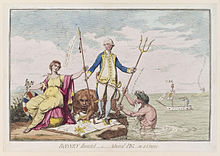Hugh Pigot (Royal Navy officer, born 1722)
Hugh Pigot | |
|---|---|
| Born | 28 May 1722 |
| Died | 15 December 1792 (aged 70) Bristol, England |
| Allegiance | Kingdom of Great Britain |
| Service/ | Royal Navy |
| Years of service | 1734–1783 |
| Rank | Admiral of the White |
| Commands held | |
| Battles/wars | |
| Relations |
|
Early career
Hugh Pigot was the third son of Richard Pigot of Westminster, by his wife Frances, daughter of Peter Goode, a
Pigot entered the navy in around 1735, serving for four years as a captain's servant and able seaman aboard the Captain under Captain Alexander Geddes on the home station, and then Seaford under Captain Savage Mostyn. He then served for another two years as a midshipman aboard the Seaford, Cumberland, and Russell. On 5 November 1741 he passed his examination, and on 9 February 1741/42 (OS) was promoted to lieutenant, and on 2 August was appointed to the Romney under Captain Thomas Grenville, in the Mediterranean.[3]

In March 1744 he followed Grenville into
He saw no further service at sea following the conclusion of the war in 1763, but in 1769 was appointed colonel of the second (or Portsmouth) division of Marines; shortly before he had been chosen as representative in parliament for the borough of
In January 1771
Flag rank

He was promoted to
By this time he was a consistent opponent of
With the fall of the government the following month,[5] on 30 March 1782 Pigot was appointed to the Board of Admiralty in the Second Rockingham ministry,[5][9] and on 24 April 1782 was promoted to full admiral[10] and appointed to supersede Sir George Rodney as commander-in-chief in the Leeward Islands Station.[11] Pigot hoisted his flag on board the 50-gun Jupiter, and sailed from Plymouth[4] on 18 May,[3] only a day before the arrival of the frigate bringing the news of the defeat of the French fleet under Comte de Grasse at the Battle of the Saintes on 12 April.[4] Although Rodney was neither in favour with the new ministry, nor a particularly popular commander, it was considered politic to allow him to remain in command and a message was sent after Pigot to recall him.[4] However, it failed to arrive before he had assumed command at Jamaica on 13 July.[3] His appointment was allowed to proceed, and Rodney received an apology and was made a Baron. Pigot, having hoisted his flag on board the 98-gun Formidable, then sailed, as was customary at that time, to America during the hurricane months.[4]
Pigot had little experience as a captain, with none as an admiral. His second-in-command,
Pigot died at Bristol on 15 December 1792.[3]
Personal life
Pigot was twice married, firstly c.1749, to Elizabeth le Neve,
References
- ^ Marshall, P. J. (2004). "Pigot, George, Baron Pigot (1719–1777)". Oxford Dictionary of National Biography. Oxford University Press. Retrieved 30 December 2013.
- ^ "Brig. Gen. Robert Pigot and the Battle of Bunker Hill". derekbeck.com. 17 June 2011. Retrieved 8 April 2014.
- ^ a b c d e f g h i j Laughton, John Knox (1896). . In Lee, Sidney (ed.). Dictionary of National Biography. Vol. 45. London: Smith, Elder & Co.
- ^ a b c d e f g h i Namier, Lewis; Brooke, John, eds. (1964). "Pigot, Hugh (1722-92), of Wichwood Forest, Oxon.". The History of Parliament: the House of Commons 1754-1790. Boydell & Brewer. Retrieved 8 April 2014.
- ^ "No. 11549". The London Gazette. 1 April 1775. p. 1.
- ^ "No. 11637". The London Gazette. 3 February 1776. p. 2.
- ^ Namier, Lewis (1961). The Structure of Politics at the Accession of George III (2nd ed.). London: St Martin's Press. p. 32.
- ^ "Sainty, JC, Lord High Admiral and Commissioners of the Admiralty 1660-1870, Office-Holders in Modern Britain: Volume 4: Admiralty Officials 1660-1870 (1975), pp. 18-31". Archived from the original on 7 October 2014. Retrieved 4 September 2009.
- ^ "No. 12290". The London Gazette. 23 April 1782. p. 1.
- ^ Haydn, Joseph (13 June 2008). The Book of Dignities: Containing Lists of the Official Personages of the British Empire ... from the Earliest Periods to the Present Time ... Together with the Sovereigns and Rulers of Europe, from the Foundation of Their Respective States; the Peerage of England and Great Britain Original 1851 Digitized by the University of Michigan. Longmans, Brown, Green, and Longmans. p. 279.
- ^ Rodger, p. 69
- ^ "Wychwood and Cornbury" (PDF). Victoria County History. p. 7. Retrieved 6 August 2017.
- ^ Ogden, Jack (April 2009). "England's largest diamond". Gems and Jewellery History. 18 (2).
Sources
- Concise Dictionary of National Biography. 1930.
- Rodger, N.A.M. (1979). The Admiralty. Offices of State. Lavenham: T. Dalton Ltd. ISBN 0900963948.

